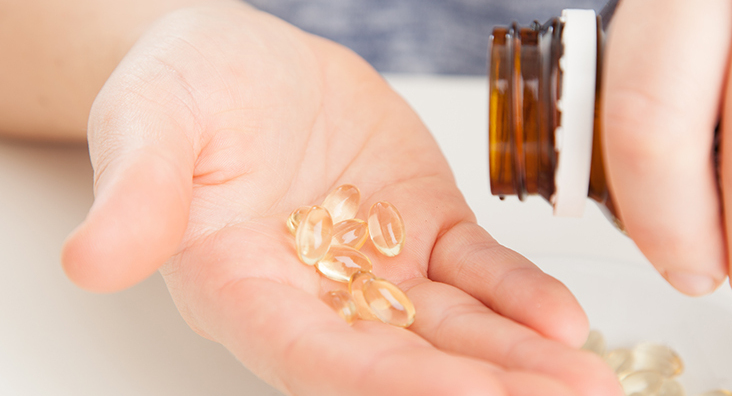Vitamin A is a fat-soluble vitamin that is essential to protect and maintain eye health, enhance the immune system, cellular interaction, and reproduction (1), (2), (3), (4), (5).
To maintain proper vision health, vitamin A, along with many other nutrients are vital (6). Other important vitamins and minerals to consider for eye health include vitamin E, vitamin A, omega 3 fatty acids, zinc, and lutein, and more. Other Vitamin A benefits include its a role in preventing macular degeneration and some cancers (1), (4), (5), (9), (10).
Vitamin A is a crucial element in supporting your immune system as well. Many people think of vitamin C when they want to give their immune system a boost (11). Vitamin A is sometimes left behind, but it is just as crucial as other nutrients like vitamin C in promoting a healthy immune system (12).



Vitamin A also protects the epithelium and mucous tissues, which are tissues that run throughout the body to protect body cavities, tissues in glands, and even organs in the body (13). Vitamin A is so powerful that another name for it is the anti-infective vitamin (14). It is also a crucial micronutrient to protect the tissues in the lungs (15).
Summary: Vitamin A is a fat-soluble vitamin essential for eye health, a strong immune system, cellular interaction, and reproduction. It is even essential for tissue health throughout the body, including the lungs. Since it is fat-soluble, too much can be harmful on the body.
Table of Contents
How Much Vitamin A is Too Much?
Unlike water-soluble vitamins like vitamin C, it is easy to take too much vitamin A because it is a fat-soluble vitamin (16). Excess water-soluble vitamins are easily removed from the body through the urine or sweat (17). It is typically extremely difficult to take too much of a water-soluble vitamin for that reason.
However, excess vitamin A and other fat-soluble vitamins are not easily removed from the body. Read on to find out how much vitamin A you need to take and if you are getting enough in your daily diet to fully support you.
It is extremely difficult and rare to get too much vitamin A from the foods you eat (4), (5), (16). But if you are taking supplements with vitamin A, you want to make sure you do not take too much for several reasons.
Another name for too much vitamin A or vitamin A toxicity is hypervitaminosis. It can happen through oral vitamin A supplementation or topical treatment. Fat-soluble vitamins accumulate in the body, unlike water-soluble vitamins (18).
Summary: Vitamin A toxicity, known as hypervitaminosis, can occur through oral vitamin A supplementation or topical treatments. Water-soluble vitamins are typically removed easily from the body through urine or sweat. However, fat-soluble vitamins accumulate in the body which can cause major issues.
As many as 60,000 Americans experience a vitamin toxicity each year, whether it is acute or chronic, although vitamin A toxicity is rare (18). If you are eating plenty of foods high in vitamin A, you are likely getting enough, although small supplementation doses usually cannot hurt (18).
There are also many interactions, where vitamin A can react with other medications. Be aware that these include blood clot medications like anticoagulants, retinoids, topical cancer drugs, drugs used for liver damage, and more (5), (19).
Taking more than 10,000 international units (IU) a day of vitamin A supplements can cause bone thinning, liver damage, diarrhea, headache, nausea, skin inflammation or irritation, joint pain, and birth defects (5), (18), (20), (21), (22).
Make sure to keep a healthy balanced diet with plenty of vitamin A and be cautious about the amount and dosage in your supplements.
Summary: Vitamin A toxicity is rare. Supplementation is only recommended for those who have a deficiency. Consuming over 10,000 IU per day of vitamin A can cause blood thinning, liver damage, diarrhea, headache, nausea, skin inflammation or irritation, joint pain, or birth defects. Vitamin A can also interact with medications such as anticoagulants, retinoids, topical cancer drugs, or liver drugs.
Symptoms of Too Much Vitamin A (Overdose)
There are many symptoms to keep in mind if you are getting or taking too much vitamin A. Vitamin A overdose can be extremely serious, so make sure to pay attention to these symptoms carefully (18).
Some common symptoms of taking too much vitamin A are gastrointestinal issues, such as diarrhea, loss of appetite, vomiting, abdominal pain, and skin issues like rashes or peeling skin (5), (18), (23).
If you experience any of these symptoms, be sure to speak to a doctor or a healthcare professional to get your levels tested. Remember that vitamin A can not easily pass through the body through sweat or urine, because it is not water-soluble. It is a fat-soluble vitamin, so it is possible to take too much (16).
Summary: Vitamin A toxicity can be very serious. Common symptoms of taking too much vitamin A include diarrhea, loss of appetite, vomiting, abdominal pain, and skin issues. If you experience any of these symptoms, speak to your healthcare provider to get your levels tested.
Side Effects
If you do take too much vitamin A, there are many common side effects to be aware of. They can range from severe to extreme (21). Be sure to keep an eye on your vitamin A intake and pay attention to any of these side effects.
Some of the less severe side effects that above include nausea, rashes, skin peeling, vomiting, loss of appetite, and abdominal pain(5), (18), (23). More severe side effects include blurry vision, vertigo, and even coma and death, to name a few (20), (21). These types of symptoms typically occur when you take more than 200,000 mcg, which is extremely rare (16).
Summary: If you have been instructed to take Vitamin A supplements, there can be side effects. Nausea/vomiting, appetite loss, abdominal pain, rashes, or peeling of the skin are some less severe side effects. More severe include blurry vision, vertigo, or in worst cases, coma. This is extremely rare and generally occurs when you take more than 200,000 mcg of vitamin A.
How Much Vitamin A Should I Take?
There are plenty of foods high in vitamin A that you can add to your regular diet and routine. An easy way to remember what foods are high in vitamin A in the form of beta-carotene is to think of orange and yellow foods (24). Sweet potatoes, carrots, carrot juice, oranges, and other yellow fruits and vegetables are all good sources of beta-carotene (5), (25).
But there are many other foods beyond the yellow and orange color that also provide vitamin A in the form of retinol. These include eggs, cod liver oil, cheese, butter, chicken, beef, and especially the liver, fortified cereals, skim milk, dark leafy greens like bok choy, spinach, kale, and much more (5). There are two types of vitamin A, preformed and provitamin A (4).
Summary: High vitamin A foods include eggs, cod liver oil, cheese, butter, chicken, beef, liver, fortified cereals, milk, and dark leafy greens. High vitamin A foods in the form of beta-carotene are generally orange or yellow in color. Sweet potatoes, carrots, and oranges are a few to name. There are two types of vitamin A, preformed and provitamin A.
Preformed comes from animal sources and supplements, while provitamin comes from plants, fruits, and vegetables (4). Both forms play a role in maintaining adequate levels of vitamin A in the tissues, cells, and the body overall (4), (26).
A balanced diet is the most important factor to keep your vitamin A levels up high, but it may sometimes benefit you to include a supplement with vitamin A as well (5). Everyone is different in what they need, and you should discuss with your doctor if it may be time to add a multi-vitamin with vitamin A to your routine.
Women should get no more than 2,700 international units (IU) of vitamin A daily (5), (16). Babies born to pregnant who consume more than 10,000 supplemented IUs of Vitamin A day are at risk of being born with disability (24), (27), (28). One study estimated that 1 in 57 babies born to mothers who took more 10,000 IU of vitamin A per day were born with a congenital disability (29).
The daily recommended intake of vitamin A for men is 900 mcg and for women who are not pregnant, it is 700 mcg per day (16). Make sure you are eating a healthy diet, and see if it is necessary to supplement with a doctor (5).
Summary: Preformed comes from animal sources and supplements. Provitamin A comes from plants, fruits, and vegetables. They both maintain adequate vitamin A levels in tissues and cells. A balanced diet is optimal to keep adequate levels. The daily recommended intake for men is 900 mcg per day and non-pregnant women 700 mcg per day. If you suspect a vitamin A deficiency or toxicity, speak with your doctor.
Conclusion
Vitamin A is an essential micronutrient that everyone needs to maintain a healthy body overall. It is especially vital to boost eye health to prevent macular degeneration, cancer, and support the immune system (1), (4), (5), (9), (10), (12), (30).
This vitamin is a crucial piece of the wellness puzzle for all humans to consider. It is important to consider your diet and supplementation, depending on your sex and stage of life (16).
While pregnant women need more vitamin A, too much can cause more harm. Vitamin A toxicity can cause severe side effects, as it is a fat-soluble vitamin that builds up in the body over time (5), (18).
Be sure to eat plenty of vegetables, fruits, and more foods rich in vitamin A to meet your daily recommended requirement (5).














